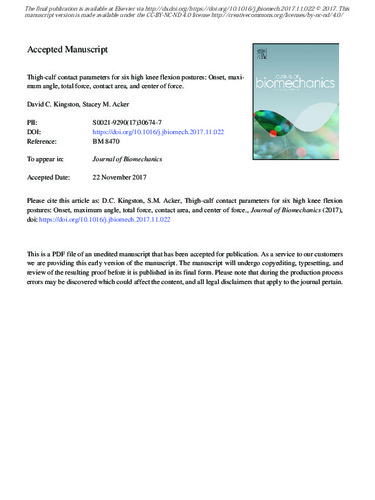| dc.contributor.author | Kingston, David C. | |
| dc.contributor.author | Acker, Stacey M. | |
| dc.date.accessioned | 2018-01-12 16:00:49 (GMT) | |
| dc.date.available | 2018-01-12 16:00:49 (GMT) | |
| dc.date.issued | 2018-01-23 | |
| dc.identifier.uri | https://doi.org/10.1016/j.jbiomech.2017.11.022 | |
| dc.identifier.uri | http://hdl.handle.net/10012/12847 | |
| dc.description | The final publication is available at Elsevier via http://dx.doi.orghttps://doi.org/10.1016/j.jbiomech.2017.11.022 © 2017. This manuscript version is made available under the CC-BY-NC-ND 4.0 license http://creativecommons.org/licenses/by-nc-nd/4.0/ | en |
| dc.description.abstract | In high knee flexion, contact between the posterior thigh and calf is expected to decrease forces on tibiofemoral contact surfaces, therefore, thigh-calf contact needs to be thoroughly characterized to model its effect. This study measured knee angles and intersegmental contact parameters in fifty-eight young healthy participants for six common high flexion postures using motion tracking and a pressure sensor attached to the right thigh. Additionally, we introduced and assessed the reliability of a method for reducing noise in pressure sensor output. Five repetitions of two squatting, two kneeling, and two unilateral kneeling movements were completed. Interactions of posture by sex occurred for thigh-calf and heel-gluteal center of force, and thigh-calf contact area. Center of force in thigh-calf regions was farther from the knee joint center in females, compared to males, during unilateral kneeling (82 and 67 mm respectively) with an inverted relationship in the heel-gluteal region (331 and 345 mm respectively), although caution is advised when generalizing these findings from a young, relatively fit sample to a population level. Contact area was larger in females when compared to males (mean of 155.61 and 137.33 cm2 across postures). A posture main effect was observed in contact force and sex main effects were present in onset and max angle. Males had earlier onset (121.0°) and lower max angle (147.4°) with onset and max angles having a range between movements of 8° and 3° respectively. There was a substantial total force difference of 139N between the largest and smallest activity means. Force parameters measured in this study suggest that knee joint contact models need to incorporate activity-specific parameters when estimating loading. | en |
| dc.description.sponsorship | NSERC Discovery Grant [418647] | en |
| dc.language.iso | en | en |
| dc.publisher | Elsevier | en |
| dc.rights | Attribution-NonCommercial-NoDerivatives 4.0 International | * |
| dc.rights.uri | http://creativecommons.org/licenses/by-nc-nd/4.0/ | * |
| dc.subject | kneeling | en |
| dc.subject | pressure | en |
| dc.subject | squatting | en |
| dc.subject | Thigh-calf contact | en |
| dc.title | Thigh-calf contact parameters for six high knee flexion postures: Onset, maximum angle, total force, contact area, and center of force. | en |
| dc.type | Article | en |
| dcterms.bibliographicCitation | Kingston, D. C., & Acker, S. M. (n.d.). Thigh-calf contact parameters for six high knee flexion postures: Onset, maximum angle, total force, contact area, and center of force. Journal of Biomechanics. https://doi.org/10.1016/j.jbiomech.2017.11.022 | en |
| uws.contributor.affiliation1 | Faculty of Applied Health Sciences | en |
| uws.contributor.affiliation2 | Kinesiology | en |
| uws.typeOfResource | Text | en |
| uws.peerReviewStatus | Reviewed | en |
| uws.scholarLevel | Faculty | en |
| uws.scholarLevel | Graduate | en |


